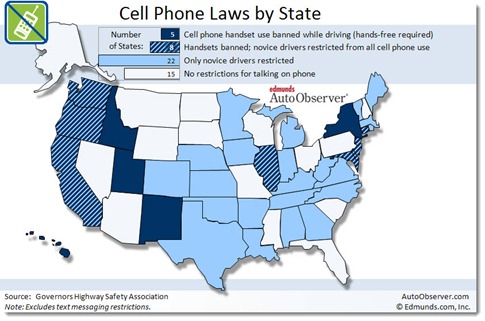Growing legislation against using cellphones while driving
Posted By RichC on March 31, 2011
Keeping and eye on (and archiving) where one can and can’t use a cellphone while driving a car (posted in an AutoObserver).
Cell Phone States of Mind
We’ve all been inspired to at least think, if not actually scream “Hang up and DRIVE!”, when we see a car drifting out of its lane, sitting motionless at a green light or slamming on the brakes at the last minute — all while the driver talks into a phone he or she is cradling in one hand. Yet, depending on where you live, said driver could be in clear violation of the law or represent entirely legal behavior.
Restrictions on driver cell phone use range from banning all activity of any kind (handheld or hands-free) to no cell phone restrictions whatsoever. In the former case, states like Colorado, Indiana and 26 others have banned any form of cell phone use by novice drivers. At the other extreme are states like Montana, Nevada and Ohio, which have no cell phone restrictions at all, including no limits on teens and school bus drivers. In between are states that only ban handheld phone use by teens, with no additional restrictions on adults.
And what happens when driver’s break these phone use restrictions? Is it a primary offense, meaning it alone is enough for a police officer to pull them over, or can drivers only be cited after being pulled over for another infraction (making it a secondary offense)? That also varies on a state-by-state level. Then there are the laws against texting while driving, which vary between states as much as the hand-held restrictions.
What does it all mean from a driver’s perspective? First, if you’re going on a cross-country road trip you better have a hands-free option for using your phone, because even if you’re home state doesn’t have any restrictions it’s likely a neighboring state does. Furthermore, it’s not uncommon for cities and counties to have their own restrictions that go beyond state laws. In the Detroit area, for example, it’s entirely possible to have a daily commute that crosses areas with restricted and non-restricted cell phone laws.
Even more disconcerting than the lack of legal consistency is the lack of both compliance and enforcement of these laws. In California, for instance, the law states that nobody — adult, teen, bus driver, extra-terrestrial, etc. — is allowed to hold a phone while operating a motor vehicle.
Yet you see this behavior all the time in the Golden State. It’s actually quite easy to spot by simply observing the cars driving erratically. Certainly the police can’t intercept every instance of a California driver holding their phone while behind the wheel. But the frequency (and blatant accident potential) of distracted, weaving drivers in a state with some of the most aggressive handheld bans suggests the legal restrictions are having minimal effect.
On April 1st, 2010 the Department of Transportation and the Environmental Protection Agency instituted new national greenhouse gas standards that every automotive manufacturer must meet, regardless of where a specific vehicle is ultimately sold in the U.S. This was the first time the federal government had established a national standard, and while the requirements to meet these new emissions standards are relatively high most automakers are thrilled to finally have only one standard to content with.
Prior to this national standard the emissions requirements had fragmented among various states, forcing automakers to either meet the emissions standards of the most restrictive states or develop multiple emissions standards and ensure the right cars went to the right states.
Now, with such a wide disparity in cell phone laws across the country, it’s the consumer that must content with multiple legal requirements based on where he is at any given moment. It’s likely this patchwork of standards is only contributing to the lack of compliance by drivers, even in states with laws against using a handheld phone. A similar situation exists with seat belt laws that currently range from primary offenses to no requirement at all (thank you New Hampshire).
And as with seat belt laws, establishing a national standard for cell phone use may be difficult, or even impossible from a purely legal standpoint. The Supreme Court is currently looking into the role of state’s rights versus uniformity of law as it relates to vehicle safety. When you strip away all the vagaries of the legal arguments the question is pretty simple: is consumer safety better served by a national standard or the ability of each state to determine its own standard?
I submit the answer is only as obvious as the drivers who are holding their phones while driving.
See the entire Karl Brauer article in AutoObserver.com.

Comments